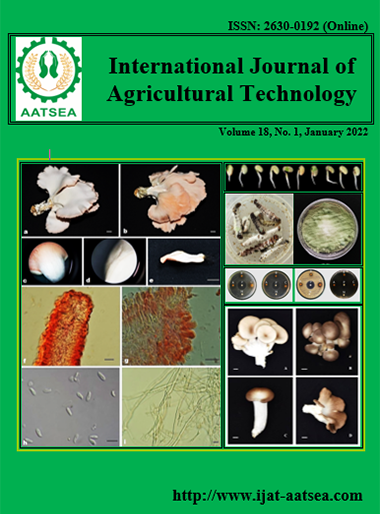Biological characteristics of the Pleurotus cultivars in southwestern Viet Nam
Main Article Content
Abstract
The biological characteristics of Pleurotus cultivars in the southwestern region of Viet Nam were conducted by morphology, molecular phylogeny, spawn running and biological efficiency. Total 10 Pleurotus cultivars were belonged to 5 morphotypes as following: 5 cultivars GTG1, GBT1, GBT2, GVL1, GVL3 belonged to phoenix type, 2 cultivars WSG1, WVL1 belonged to oyster type, a cultivar YVL1 belonged to golden oyster type, a cultivar PVL1 belonged to pink oyster type, and a cultivar DgSG1 belonged to blue oyster type. By morphological and phylogenetic analysis, all 5 phoenix cultivars were identified to P. pulmonarius, both 2 oyster cultivars and a blue oyster cultivar were P. ostreatus, a golden oyster cultivar was P. citrinopileatus, and a pink oyster cultivar was P. djamor. By the model of 1.2 kg rubber tree sawdust in nylon bag, the spawn running of golden oyster cultivar (12.47±1.20 mm/day) and pink oyster cultivar (11.29±1.00 mm/day) was higher than all phoenix cultivars, and the spawn running of blue oyster cultivar was lowest (6.57±0.76 mm/day). The biological efficiency in conventional production of oyster cultivars was highest (37.58±5.00% of WSG1 and 34.84±3.90 of WVL1), opposite to blue oyster cultivar was lowest (12.93±3.93%). This the first study described the macro and micro morphological characteristic of commercial mushroom cultivars in Viet Nam. Combining the molecular and morphological identification, all these cultivars could be used as the parent in crossing due to their putative strain and standard characteristic of species. The results of cultivation under a standardized conditions should be a value data to screen and breed the new cultivar
Article Details

This work is licensed under a Creative Commons Attribution-NonCommercial-NoDerivatives 4.0 International License.
References
Boekhout, T., Bas, C. and Noordeloos, M. E. (1990). B. taxonomy part: Pleurotaceae. In: Bas C et al ed. Flora Agaricina Neerlandica, Rotterdam, A. A. Balkema Publisher, pp.20-24.
Buchanan, P. K. (1993). Identification, names and nomenclature of common edible mushrooms. In: Chang ST et al ed. Mushroom biology and mushroom products, Hong Kong, The Chinese University Press, pp.21-32.
Kimura, M. (1980). A simple method for estimating evolutionary rates of base substitutions through comparative studies of nucleotide sequences. Journal of Molecular Evolution, 16:111-120.
Kumar, S., Stecher, G. and Tamura, K. (2016). Molecular Biology and Evolution, 33:1870-1874.
Corner, E. J. H. (1981) Beihefte zur Nova Hedwigia, Heft 69: The Agaric Genera: Lentinus, Panus, and Pleurotus with particular reference to Malaysian species, Gantner Verlag Kommanditgesellschaft, J. Cramer, pp.102-111.
Largent, D. (1977). How to identify mushrooms to genus I: Microscopic features, California, Mad River Press Inc., 86p.
Largent, D., Johnson, D. and Watling, R. (1977). How to Identify Mushrooms to Genus III: Microscopic Features, California, Mad River Press Inc., 148p.
Lechner, B. E., Wright, J. E. and Alberto, E. (2004). The genus Pleurotus in Argentina. Mycologia, 96:845-858.
Li, J., He, X., Liu, X. B., Yang, Z. L. and Zhao, Z. E. (2017). Species clarification of oyster mushrooms in China and their DNA barcoding. Mycological Progress, 16:191-203.
Li, J., Liu, X. B., Zhao, Z. W. and Yang, Z. L. (2019). Genetic diversity, core collection and breeding history of Pleurotus ostreatus in China. Mycoscience, 60:14-24.
Miah, M. N., Begum, A., Shelly, N. J., Bhattacharjya, D. K., Paul, R. K. and Kabir M. H. (2017). Effect of different sawdust substrates on the growth, yield and proximate composition of white oyster mushroom (Pleurotus ostreatus). Bioresearch Communications, 3:397-410.
Nguyen, H. M., Truong, B. N., Phan, H. D. and Le, B. D. (2019). Cultivation of oyster mushroom (Pleurotus spp.) using fermentation substrate. Dalat University Journal of Science, 9:104-111.
Nguyen, V. H. and Pham, V. D. (2013). Agriculture and Agricultural extension Forum, The 14th topic of Developing Effective Mushroom Cultivation, Viet Nam Agricultural Extension, Cao Lanh, Dong Thap Province, pp.17-25.
Pegler, N. D. (1986). Kew BulletinAdditional Series XII: Agaric flora of Sri Lanka, London, Her Majesty Stationary Office, pp.41-46.
Rajarathnam, S., Bano, Z. and Miles, P. G. (1987). Pleurotus mushrooms. Part I A. morphology, life cycle, taxonomy, breeding, and cultivation. CRC Critical Reviews in Food Science and Nutrition, 26:157-223.
Ritota, M. and Manzi, P. (2019). Pleurotus spp. Cultivation on Different Agri-Food By-Products: Example of Biotechnological Application. Sustainability, 11:5049.
Royse, J. D., Baar, J. and Tan, Q. (2017). Chapter 2: Current overview of mushroom Production in the World. In: Diego CZ and Pardo-Giménez A ed. Edible and Medicinal Mushrooms: Technology and Applications, West Sussex, John Wiley & Sons Ltd., pp.5-13.
Segedin, P. B., Buchanan, P. K. and Wilkie, J. P. (1995). Studies in the Agaricales of New Zealand: New species, new records and renamed species of Pleurotus (Pleurotaceaea). Australian systematic botany, 8:453-482.
Shah, Z. A., Ashrad, M. and Ishtiaq, Ch. M. (2004). Comparative study on cultivation and yeild performance of oyster mushroom (Pleurotus ostreatus) on differnce subtrates (wheat straw, leaves, saw dust). Pakistan Journal of Nutrition, 3:158-160.
Saghai-Maroof, M. A. (1984). Ribosomal DNA spacer-length polymorphisms in barley: Mendelian inheritance, chromosomal location, and population dynamics. Proceedings of the National Academy of Sciences of the United States of America, 81:8014-8018.
Singer, R. (1943). Das System der Agaricales. III. Annales Mycologici, 41:1-189.
Stamets, P. (2000). Growing Gourmet and Medical Mushrooms, New York, Ten Speed Press, 614p.
Tamura, K., Nei, M. and Kumar, S. (2004). Prospects for inferring very large phylogenies by using the neighbor-joining method. Proceedings of the National Academy of Sciences, 101:11030-11035.
Truong, B. N., Okazaki, K., Le, X. T. and Suzuki, A. (2008a). Inter-subspecies hybrid dikaryons of oyster mushroom independently isolated in Vietnam and Japan. Biochemistry & Molecular Biology Notes, 72:216-218.
Truong, B. N., Suzuki, A., Nakaya, M. and Le, X. T. (2008b). Changes in texture of the post-harvest fruit-bodies of an abalone mushroom, Pleurotus cystidiosus subsp. abalonus, cultivated on different agro-forestry wastes. Mushroom Science and Biotechnology, 16:109-116.
White, T. J., Bruns, T., Lee, S. and Taylor, J. W. (1990). Amplification and direct sequencing of fungal ribosomal RNA genes for phylogenetics. In: Innis MA et al ed. PCR Protocols: A Guide to Methods and Applications, New York, Academic Press Inc., pp.315-322.


